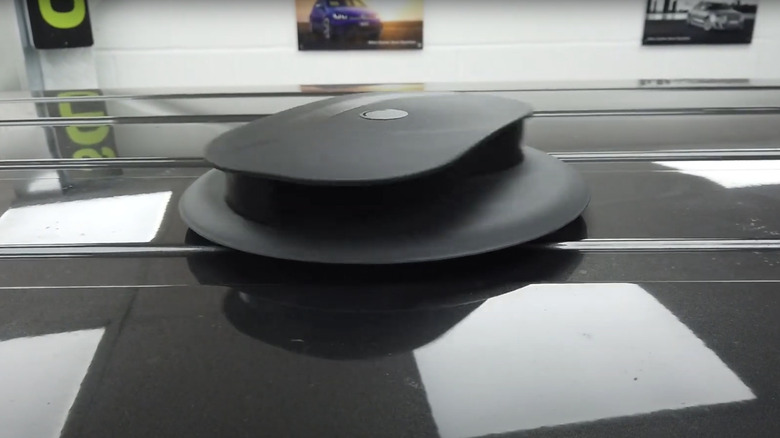Here's What That Spinning Thing On Top Of Delivery Trucks Is For
Through the years, delivery trucks have had to manage the impact of e-commerce and global supply chains to the sheer quantity of their workload, as well as widened delivery maps in increasingly congested environments. In recent times, we've mentioned several ways that delivery giants have been experimenting with improving their fleets, especially when it comes to technology. In 2020, we reported on Amazon's early steps into reducing their delivery fleet's emissions with electric vehicles through its partnerships with Mercedes-Benz and Rivian. A year later, FedEx started experimenting with autonomous truck delivery in 2021. Earlier this year, USPS added big upgrades to its trucks, including better sensors, camera systems, and improved interiors.
However, one common problem that delivery trucks often encounter is the struggle of maintaining interior temperature. Unlike other vehicles, delivery trucks experience the constant opening and closing of doors. Because of this, they can struggle to maintain a comfortable temperature for the driver, as well as any sensitive packaging in the cargo. Thankfully, someone has figured out a genius (and simple solution) to this problem — the spinning thing on top of it. Referred to as a Flettner ventilator, it is designed to help keep a delivery truck cool by encouraging airflow. According to Flettner, one of its customers has even shared that its ventilators were able to successfully lower the internal temperature in its van up to 15 degrees Fahrenheit. So, how does it do this exactly?
How does a Flettner Ventilator work on vehicles?
Designed to move quietly and without needing to be charged, the Flettner Ventilator works by circulating air in the vehicle using its movement, as well as the force of the wind. To do this, its circulating fan is moved by air that passes through its air scoop while the vehicle is in motion. At the same time, stale air from inside the vehicle is pulled out as well. While it lets air flow freely, it's designed not to let things like rain and dust get into the van's precious cargo.
Flettner lists several ventilator models up for sale on its website. If you're wondering what Flettner Ventilator was spinning on the passing delivery truck, its size itself can be your biggest clue. For example, the Flettner 2000 Ventilator was designed to fit up to medium-sized vans, while the Flettner TCX-2 Ventilator was made for larger vans. With over 80 years of history, Flettner has proven its commitment to producing quality products, so much so that each ventilator has a lifetime warranty. However, there are other alternative brands that utilize similar features as well.
In the future, we're probably going to see more parcel delivery via other methods, like drones. Just last year, we've mentioned how Amazon had already attempted to launch its prescription drone delivery service through its Prime Air service. But for now, delivery trucks and these little spinning things seem like they're here to stay.
Where else can you find Flettner rotors?
Apart from the standard ventilators for vehicles, Flettner even produces floor vents which help improve ventilation further by producing a vertical draft without the risk of introducing particles into the car. Plus, it also offers building ventilator options for things like waste gas extraction. Interestingly, delivery trucks aren't the only vehicles that use a Flettner rotor. Developed in the 1920s, it was designed by German inventor, Anton Flettner, for use on both ships and planes. On ships, the Flettner rotors were cylindrical sails used to generate propulsion using wind. According to the International Maritime Organization (IMO), ship rotors can generate up to 160W at 250 revolutions per minute (rpm). A few years later, Anton Flettner also began producing ventilators designed for light aircraft out of Sweden.
That said, delivery services aren't the only ones that can benefit from adding one to their everyday ride. In fact, many people living the van life, travel with trailers, or who transport animals have opted to add them for improved ventilation as well. If you ever get the urge, they are typically easy to install and have adapters for vehicles lined with materials like plywood. However, it's important to note that improving ventilation may not exactly solve your problem if your car's air conditioner is blowing warm. In some cases, you may need to get it professionally checked for possible issues with its different components or is running low on refrigerant.



